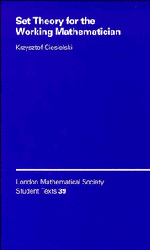Book contents
- Frontmatter
- Contents
- Preface
- Part I Basics of set theory
- 1 Axiomatic set theory
- 2 Relations, functions, and Cartesian product
- 3 Natural numbers, integers, and real numbers
- Part II Fundamental tools of set theory
- Part III The power of recursive definitions
- Part IV When induction is too short
- A Axioms of set theory
- B Comments on the forcing method
- C Notation
- References
- Index
3 - Natural numbers, integers, and real numbers
from Part I - Basics of set theory
Published online by Cambridge University Press: 05 June 2012
- Frontmatter
- Contents
- Preface
- Part I Basics of set theory
- 1 Axiomatic set theory
- 2 Relations, functions, and Cartesian product
- 3 Natural numbers, integers, and real numbers
- Part II Fundamental tools of set theory
- Part III The power of recursive definitions
- Part IV When induction is too short
- A Axioms of set theory
- B Comments on the forcing method
- C Notation
- References
- Index
Summary
From the results of Section 1.2 it is clear that sets such as ∅, {∅}, {∅, {∅}}, {{∅}}, and so forth exist. Using the axiom of infinity we can also conclude that we can build similar infinite sets. But how do we construct complicated sets, such as the sets of natural and real numbers, if the only tools we have to build them are the empty set ∅ and “braces” {·}? We will solve this problem by identifying the aforementioned objects with some specific sets.
Briefly, we will identify the number 0 with the empty set ∅, and the other natural numbers will be constructed by induction, identifying n with {0, …, n − 1}. The existence of the set ℕ of all natural numbers is guaranteed by the infinity axiom. The real numbers from the interval [0,1] will be identified with the set of functions {0,1}ℕ, where an infinite sequence a: ℕ → {0,1} is identified with the binary expansion of a number, that is, with Σn∈ℕa(n)/2n+1. The details of these constructions are described in the rest of this chapter.
Natural numbers
In this section we will find a set that represents the set ℕ of natural numbers in our set-theoretic universe. For this, we need to find for each natural number n a set that represents it. Moreover, we will have to show that the class of all such defined natural numbers forms a set.
Information
- Type
- Chapter
- Information
- Set Theory for the Working Mathematician , pp. 25 - 34Publisher: Cambridge University PressPrint publication year: 1997
